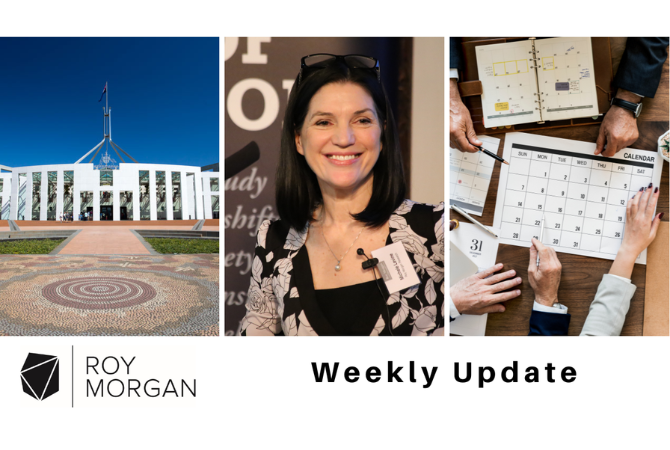Roy Morgan Update November 18, 2025: Federal Vote, Consumer Confidence and Annual Leave

In this week's Market Research Update, we present the latest data on Federal Vote, Consumer Confidence and Annual Leave.
Welcome to the Roy Morgan Weekly update.
First, breaking news, a changing of the guard in Victoria – the Victorian Liberal Party elected its first ever Female Leader – 35 year old Jess Wilson – representing a new generation coming through to challenge the Labor Government of Jacinta Allen at next year’s Victorian Election.
We will be keeping a close eye on the Victorian political situation over the next year – set to be the first Victorian Election contested by two women in the top jobs.
Now to Federal Politics, the latest Roy Morgan Poll conducted in November with an Australia-wide cross-section of 5,248 electors;
Support for One Nation up 2% to 14% - its highest level of support for over 27 years since July 1998 while support for the ALP was down 2% to 33%. Support for the Coalition was unchanged on 27%, the Greens down 0.5% to 12.5%, and support for Independents/ Other Parties up 0.5% to 13.5%.
This increasing support for One Nation should come as no surprise. Viewers will recall Roy Morgan has been monitoring the rise of disaffected, disengaged Australians over the last year in several releases – including “Over 1 Million Disenfranchised Australians Feel Left Behind” and “Disconnected from Government and A Dangerous Convergence: Disaffection and the rise of ‘Sovereign Citizens’” that can be found on the Roy Morgan website.
The latest figures show there were 1.15 million ‘Disaffected Australians’ and that these people were 2.5 times more likely to support One Nation than other Australians.
On a two-party preferred basis support for the ALP was virtually unchanged at 56.5% well ahead of the Coalition on only 43.5%.
However, the latest Roy Morgan Government Confidence shows 51.5% of Australians say the country is ‘going in the wrong direction’ compared to only 33.5% that say the country is ‘going in the right direction’.
So, Government Confidence is only 82 in November.
Last week ANZ-Roy Morgan Consumer Confidence was up 0.7 points to 84.2. The increase in Consumer Confidence was driven by improving sentiment that now is a ‘good time to buy’ major household items – up 4% to 24% - as we head towards next week’s Black Friday and Cyber Monday sales weekend.
The latest Roy Morgan forecast released in conjunction with the Australian Retailers Association shows Australians are poised to spend a record $6.8 billion over the four day sales weekend – up 4% on last year.
The weekly ANZ-Roy Morgan Inflation Expectations was unchanged for a third straight week at 5.2%.
So, Australians are now expecting annual inflation of 5.2% each year over the next two years.
New data from Roy Morgan shows over 9.7 million Australians in paid employment now have 209 million days of annual leave due; up from 200 million days two years ago.
There are a further 5.2 million workers in paid employment who have no leave.
Over the last four years the average days of annual leave due per worker has remained virtually unchanged at 14 days but the overall total has increased, or decreased, based on the number of Australians employed.
The accrued annual leave of 209 million days is down slightly from the record high reached earlier this year, and driven lower by a decline in overall employment this year which was highlighted in the most recent Roy Morgan monthly release on employment and unemployment.
New data from Roy Morgan on solar energy systems shows 32% of Australian households have some form of Solar Energy System, which can be a solar hot water system, a solar heated swimming pool or rooftop solar panels with or without battery systems – and these figures include 27% of households with Solar Panels and 5% with Solar Panels and Storage Batteries.
That equates to over 3.3 million Australian households that now have access to solar energy.
The highest incidence of solar energy systems are in Western Australia and South Australia (both on 41%), followed by the Northern Territory (39%) and Queensland (37%).
Incidence is significantly lower in Victoria (28%), New South Wales (26%), and unsurprisingly, lowest of all in Tasmania at just 23%.
For further information on the Solar Energy system market in Australia head over to the Roy Morgan website.
Margin of Error
The margin of error to be allowed for in any estimate depends mainly on the number of interviews on which it is based. Margin of error gives indications of the likely range within which estimates would be 95% likely to fall, expressed as the number of percentage points above or below the actual estimate. Allowance for design effects (such as stratification and weighting) should be made as appropriate.
| Sample Size | Percentage Estimate |
| 40% – 60% | 25% or 75% | 10% or 90% | 5% or 95% | |
| 1,000 | ±3.0 | ±2.7 | ±1.9 | ±1.3 |
| 5,000 | ±1.4 | ±1.2 | ±0.8 | ±0.6 |
| 7,500 | ±1.1 | ±1.0 | ±0.7 | ±0.5 |
| 10,000 | ±1.0 | ±0.9 | ±0.6 | ±0.4 |
| 20,000 | ±0.7 | ±0.6 | ±0.4 | ±0.3 |
| 50,000 | ±0.4 | ±0.4 | ±0.3 | ±0.2 |



